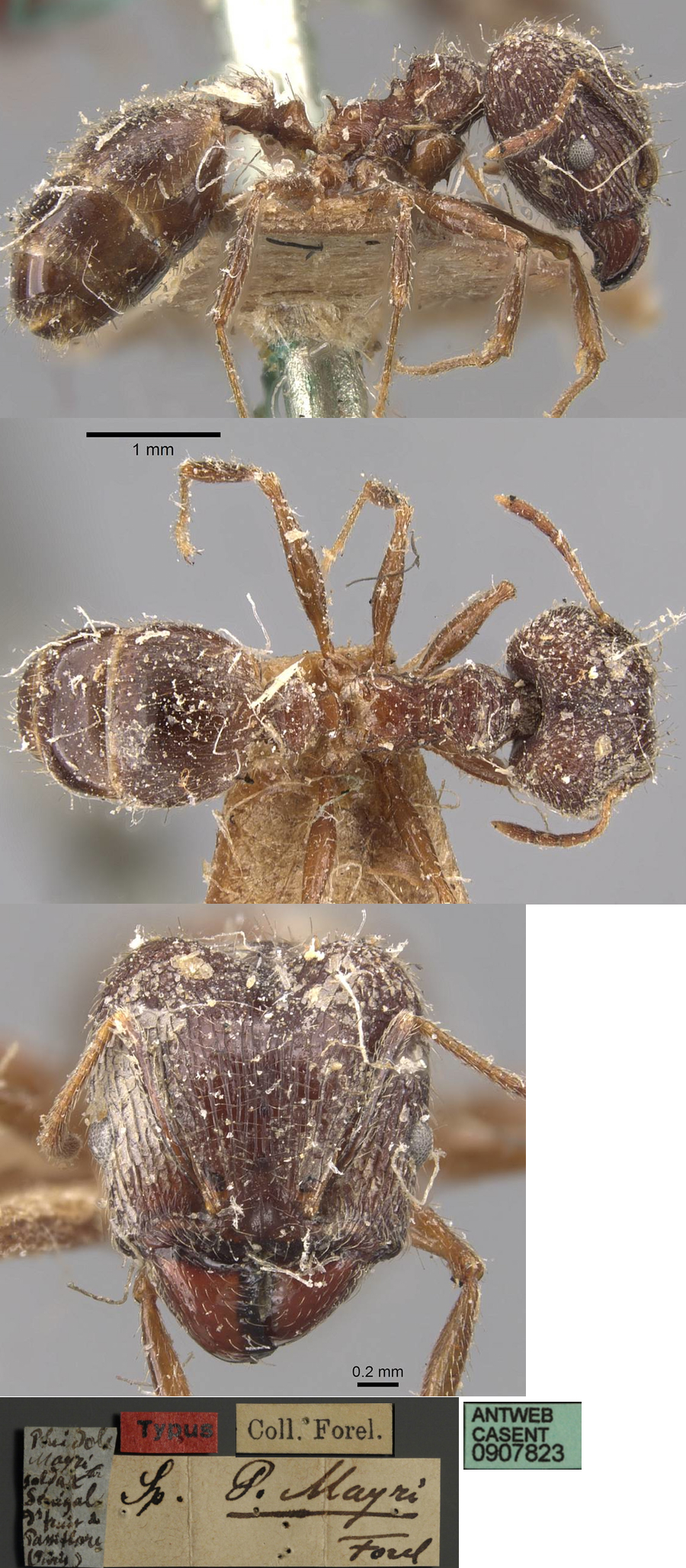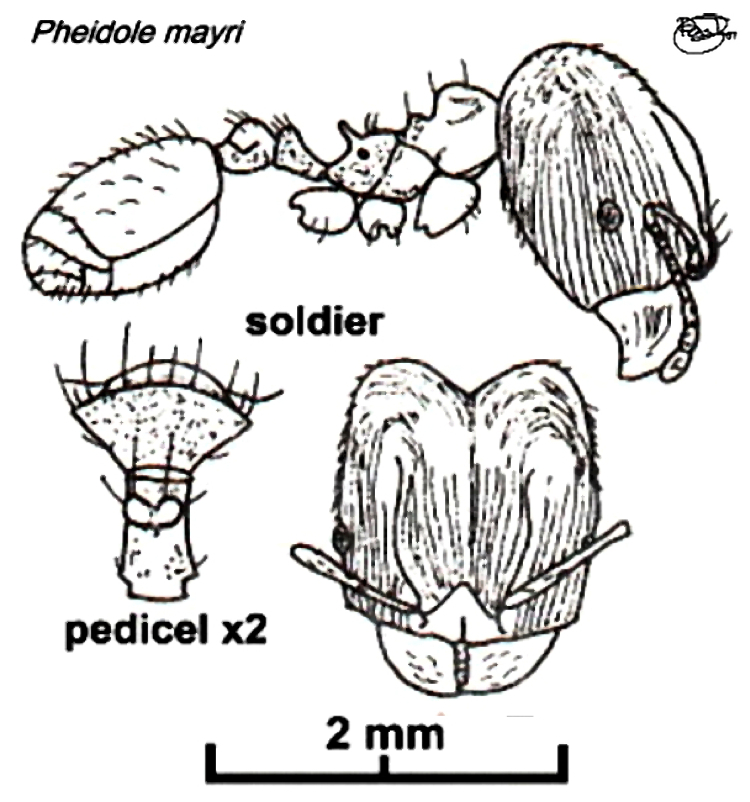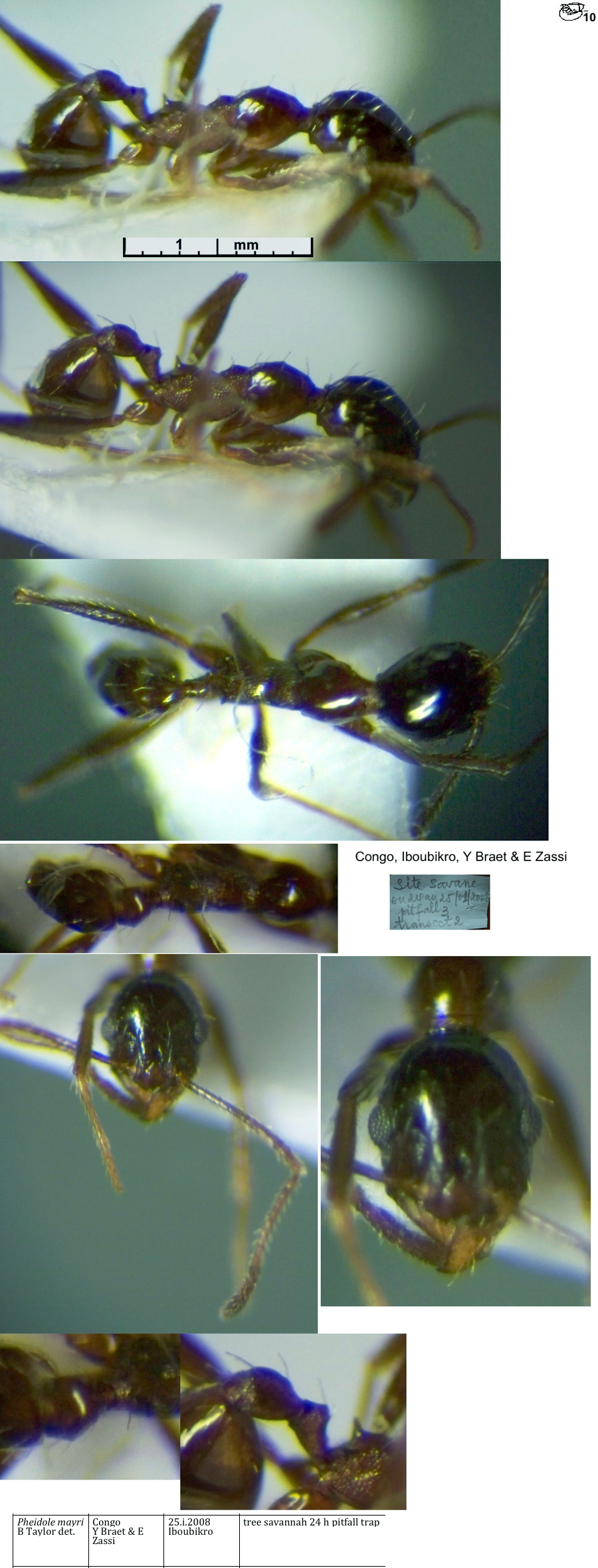Pheidole mayri Forel
  Type location Senegal
(Pheidole Mayri, n. spec.
Forel, 1894b: 91, major & minor) no details - see below; major
& minor
described (see Bolton, 1995) Type location Senegal
(Pheidole Mayri, n. spec.
Forel, 1894b: 91, major & minor) no details - see below; major
& minor
described (see Bolton, 1995)  . .
|
Forel's (1894b) description is at  . Translation by Hauke Koch - Pheidole
mayri . Translation by Hauke Koch - Pheidole
mayri
Major: TL 4.4-4.8 mm. Mandibles and clypeus identical to the previous [Pheidole
sculpturata r berthoudi]. Head only slightly or barely
longer than wide, wider at the base than at the front, at the base
deeply incised, approximately as in rhombinoda [Pheidole
rhombinoda Mayr, 1879: 678, from India] that is very similar to
this species. The strongly diverging frontal carinae are protruding to
the hind third of the head, and spare a groove for the scapus [scrobe],
that reaches the hind third of the head as well. In all parts identical
to P. rhombinoda, as well in sculpture, colour and pilosity,
but the propodeum has two rather long, thin spines, which are 2/3 as
long as their distance and slightly curved inwards. The petiole is
extremely short, wider than long (longer than wide in rhombinoda),
frontally with blunt edges (sharp in rhombinoda),
frontal-ventrally with a long lamellate, slightly translucent tooth
(without tooth in rhombinoda). The postpetiole as in rhombinoda,
very broad and rounded, with transparent hind part of the lateral
margin, but much wider than long and ventrally with a small tooth
(hardly wider than long and without ventral tooth in rhombinoda).
Basal half of the first gastral segment barely shiny, finely reticulate
and spaciously longitudinally striate.
Minor: TL 2.5-2.7 mm. Slightly compacter than rhombinoda, the
head with a distinct occipital margin (more rounded in rhombinoda).
Propodeum totally unarmed (with two sharp spines in rhombinoda).
Otherwise identical, especially the large postpetiole. Collected from a
passion fruit from Senegal, wherein a lot of soldiers and workers were
included alive with their larvae. The fruit had just arrived from
Senegal in Paris as I myself had, and the ants were donated alive to me
by Mister J. Künckel. The similarity and relation to the Indian form is
so striking, that I have to pose the question if it is not an Indian
species, that had nested in the steamboat and there entered the passion
fruit.
Mayr's (1879) description of P. rhombinoda, from
Calcutta, India, is at  ; Bingham (1903: 250) gave a translation of
rhombinoda from South Asia, this is at ; Bingham (1903: 250) gave a translation of
rhombinoda from South Asia, this is at  . .
|
 The photomontage of a
type major worker is collated
from http://www.antweb.org/specimen.do?name=casent0907823. The photomontage of a
type major worker is collated
from http://www.antweb.org/specimen.do?name=casent0907823.
|
 The photomontage of a
type minor worker is collated
from http://www.antweb.org/specimen.do?name=casent0907824. The photomontage of a
type minor worker is collated
from http://www.antweb.org/specimen.do?name=casent0907824.
|
I have treated the specimens from Nigeria that I
originally labelled as Pheidole species T˛ as representative of
mayri as they are readily separable from Pheidole bayeri
(Forel), which I have raised from the all too common Forel status
of subspecies of caffra. The further specimens from the Central
African Republc (below) are a good match. The majors and minors of
both samples do seem remarkably close to Pheidole rhombinoda
(as translated by Bingham, 1903). The minors differ from Forel's
description in having propodeal spines, like rhombinoda.
|
 Nigeria
specimen (Pheidole species T˛ in Taylor, 1980a: . Nigeria
specimen (Pheidole species T˛ in Taylor, 1980a: .
Major - TL 5.76, HL 1.71, HW 1.59, SL 0.90, PW 0.75;
spiculate on lateral mesonotum, propodeum and pedicel; head markedly
rugose all over, more reticulate on the occiput; frontal carinae long,
equal to the scapes in length. Alitrunk dorsum transversely faintly
rugose; pronounced dorsolateral tubercles, spines moderately long,
narrow and parallel-sided with a blunt apex. Postpetiole produced
laterally to form triangular prominences in dorsal view.
|
 Nigeria
specimen (Pheidole species T˛ in Taylor, 1980a: . Nigeria
specimen (Pheidole species T˛ in Taylor, 1980a: .
Minor - TL 3.08, HL 0.75, HW 0.56, SL 0.89, PW 0.42;
with unusually large eyes; head, pronotum and gaster unsculptured;
propodeal spines thick and blunt.
|
Oxford University Museum
specimens
Pheidole mayri
B Taylor det.
|
Liberia
E Poirier
Yekepa Camp 4
PF 2
|
6.iv.2013
Nimba County
07°33’04" N
08°33’17" E
|
Pitfall trap
Floodplain & marsh
501 m asl
minor
|
2
|
 |
Pheidole mayri
B Taylor det. |
Ivory Coast
Erena Dupont
iii.2014
|
Taď National Park
5˚45'00" N
7˚07'00" W
|
23
minor
|
3
|
 |
Pheidole mayri
B Taylor det.
|
Congo
Y Braet & E Zassi
|
25.i.2008
Iboubikro
|
tree savannah, 24 h
pitfall trap
|
1
|
 |
|
 The photomontage is of
a minor worker from Liberia, Yekepa, 2013,
collector E Poirier (Camp 4 PF2). The photomontage is of
a minor worker from Liberia, Yekepa, 2013,
collector E Poirier (Camp 4 PF2).
|
 The photomontage is of
a minor worker from Ivory Coast, Tai;
collector Erena Dupont, iii.2014. The photomontage is of
a minor worker from Ivory Coast, Tai;
collector Erena Dupont, iii.2014.
|
 The photomontage
is
of a minor worker from Congo, Iboubikro, 25.i.2008,
collectors
Yves Braet & Eric
Zassi. Apart from being somewhat small this appears to be a good match
for the type minor (above). The photomontage
is
of a minor worker from Congo, Iboubikro, 25.i.2008,
collectors
Yves Braet & Eric
Zassi. Apart from being somewhat small this appears to be a good match
for the type minor (above).
|
|